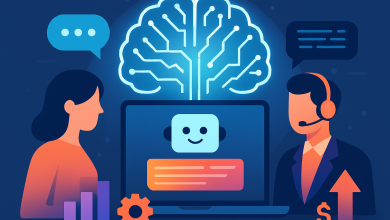
Evidence of AI’s rapid advancement is everywhere.
Now the world is moving into the Agentic Era.
This new Agentic Era – in which intelligent agents act autonomously – represents a fundamental shift that is transforming everything from computing to how systems are built, to how humans interact with software and services, to how AI integrates into the physical world.
AI is evolving from reactive assistants to proactive agents that aren’t just tools, they act as colleagues. Agentic AI can pursue goals, make decisions and perform multi-step tasks.
These proactive agents are now becoming part of operating systems. These AI OSs can act as orchestration platforms to manage, coordinate and govern multiple AI agents. This means you can deploy an army of agents to automate virtually any process – anything from a legal agent to a terms and conditions agent to a statement of work agent to a compliance agent – and have an executive agent provide each one with the marching orders it needs to accomplish the work.
Agents are force multipliers, creating a flywheel effect. AI is self-refining, so the more you use it, the faster your organization evolves. That really changes the way we think about AI.
With Agentic AI, humans won’t use computers in the same way. The agent becomes the interface – changing how every digital surface will be built and how products are designed and delivered. In fact, agents will actually be able to build the needed interfaces on the fly, tuning them to the task and your preferences. This is the biggest UX disruption since the iPhone.
The future of UX is multimodal. Agents will be able to see through your glasses, providing real-time information overlays, hands-free interaction and details on what you’re looking at. They can also listen to your voice commands and act alongside you on shared screens. This may seem far off, but adoption is happening. Meta has sold millions of Ray-Ban Meta smart glasses, and it expects to produce 10 million of these products by the end of 2026. In the not-too-distant future, you may be able to wear such glasses to an industry event and be presented with the name and details about a fellow attendee before you’re even done shaking their hand.
AI is stepping out of the cloud and into the real world. Amazon has introduced an AI-powered warehouse robot with a sense of touch. UPS, which recently announced it was laying off 20,000 workers, is looking to deploy humanoid robots, which can work in existing delivery centers so the company won’t have to build specialized robotic facilities. And surgical robots can now perform intricate tasks. Physical AI is the next frontier, where intelligence meets embodiment.
All of the above mean that businesses can do more, faster – but they must also take great care.
Address AI safety and security. A growing number of people use ChatGPT and similar tools for work regularly. If businesses don’t have the right policies in place, they run the risk of leaking data to such free AI websites. Now that AI is evolving to act independently, AI safety and security are of the utmost importance. However, people themselves simply can’t keep up with the progress that AI is making daily, so the only way businesses can address AI safety and security is by leveraging AI – integrating compliance into the agentic framework. To avoid hallucinations, businesses can also build agents with small circles of influence and then string those various agents together. Minimum viable intelligence reduces a business’s risk profile.
Understand the power of physical AI. Once AI is in a physical environment, anything one robot learns, the entire swarm of robots will understand. The possibilities are endless in a world in which AI has an ever-increasing skillset, businesses have the ability for mechanization and automation they’ve never had before, agents act independently, and actions can be physical.
Embrace AI. The pace at which AI is unfolding may seem overwhelming. But the best way to prepare yourself and your business to be creative with AI is to start using tools such as ChatGPT Advanced Voice Mode, Grok Voice and the Gemini multimodal AI model. Not sure where to start? No problem. The instruction manual on how to use these AI tools is built into the agents. If you ask AI to teach you how to use it, your expertise in using AI will grow astronomically.
Agentic AI is here, and it will change how companies across sectors – from media businesses to banks to retail operations to healthcare to live sports entities and beyond – will operate.
This isn’t science fiction. The infrastructure exists. The opportunity is now.
The Agentic Era is redefining the very idea of work.
Leaders who embrace this shift won’t just adapt – they’ll accelerate.





